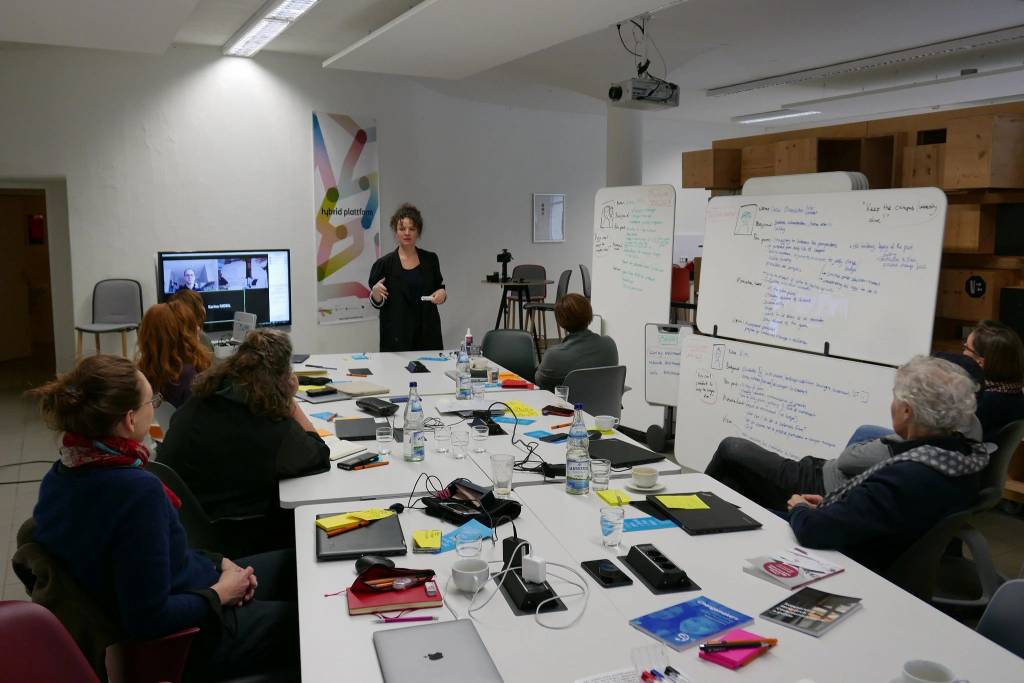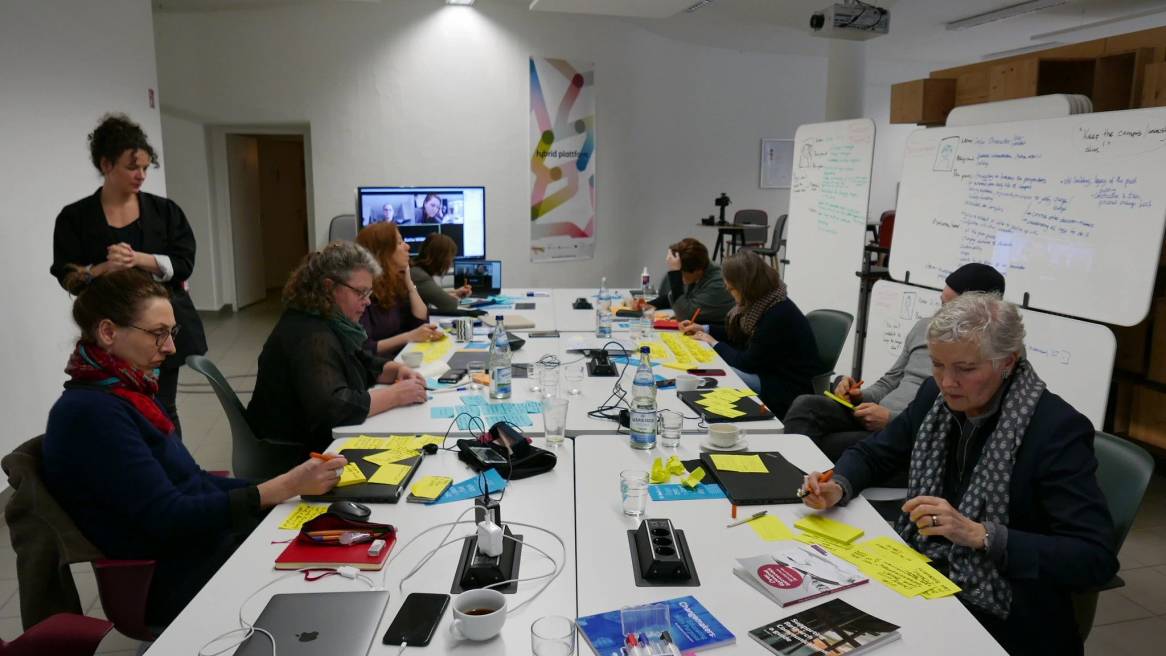Hybrid Environments for Universities
A collaborative Book Sprint project.
In the beginning of March 2020, just before the COVID-19 pandemic hit Europe, nine international experts from Germany, Sweden, Finland and Netherlands met in an education pop-up space from Steelcase Education to discuss a research question and to write a book in five days. The result of this joint adventure at Technical University (TU) Berlin is the handbook and manifesto “Hybrid Environments for Universities: A shared commitment to campus innovation and sustainability.”
The book was written in a collaborative process, a Book Sprint, that captures the knowledge and expertise of several writers who share authorship and a collective voice. The sprint process relied on high commitment from all the participants, strong facilitation, a dedicated working space supporting agile working and a fast publishing process.
A trending field: Hybrid environments for learning & working
The central question of the summit was: which organizational structures and processes at universities support a strategic as well as innovative campus development? Rapid innovation cycles in the knowledge society evoke technological and cultural transformation processes, which lead to fundamental changes in shaping our physical environments. As experts with an interdisciplinary background including the social sciences, public real estate, urban planning, architecture and landscape architecture, the participants examined the question from a holistic perspective and gained new insights.
In the resulting manifesto, the authors state necessary steps and strategies to create innovative and sustainable hybrid environments for universities – which is even more important for post-COVID learning and working spaces. The publication addresses all decision makers – executives, practitioners and contributors – as all of us are facing the challenge of limited resources and needing to do more with less.
“We have huge challenges and we need experts to come together to create solutions. We chose the Book Sprints method because it is a way to work collaboratively. It is not just about presenting research results we already have, but bringing our expertise together and merging it to something new,” says Dr. Katja Ninnemann, Corporate Learning Architecture at TU Berlin & SRH Higher Education.

A pop-up space to foster collaboration
TU Berlin applied for the education pop-up space from Steelcase Education for the Book Sprint in March. Prior to the project, Steelcase and the sprint organizers defined the functionalities that the space would need to support a collaborative writing process. The space was conceived as an active learning and agile workshop environment and set up in the Hybrid Lab of TU Berlin. A variety of zones for different work modes to support concentration, collaboration and networking were set up.
The core zone consisted of a central large table surrounded by mobile whiteboards where all participants – remote and on site – could come together to communicate and visualize ideas, challenges, timelines, tasks and more. Various semi-separate areas were available for working individually or in small groups, either sitting or standing.
Some writers were unable to join in person because of the first COVID-19 travel restrictions. Surface Hub mobile screens allowed remote participants to contribute with those on site. And portable whiteboards in different sizes let participants easily take their ideas from a small group back to the larger team. Additional breakout areas for rejuvenation and a small kitchen area, allowed informal exchange and networking during lunch in a relaxed atmosphere.
“The space and the overall great resources on site had a very positive influence on the different stages of the collaborative writing process,” says Karina Piersig, instructional designer and sprint facilitator at Book Sprints. “The authors rapidly adopted the portable whiteboards and different writing materials to map out content and carry it with them when they switched from the breakout groups back to the full team.”

From zero to book in five days
The Book Sprints method was first developed by Adam Hyde and has continued to evolve over more than a decade by Book Sprints Limited. For this book project, the Book Sprints team led the process with specific facilitation techniques, time boxes and a selection of tools. The cross-disciplinary group of authors came together to set the boundaries of the trending field of innovative campus development. The Book Sprints allocated ample time in the beginning for developing a shared mental model around the topic and the scope, audience, and style of the book. Throughout the week, the facilitators guided the evolving conversation and consensus on the main arguments of the book and steered the writers through a very iterative process of structuring, drafting and editing over and over again.
The book topic focuses on the campus space and the interactions within the space and it required a comprehensive visual design to illustrate the authors’ ideas and concepts. While the book was written, a book production team worked remotely and around the clock to turn the authors’ sketches into illustrations, create a customized book design and copy edit. At the end of the Book Sprint, there was a designed, illustrated and copy edited book approved by the writers.
Rapid book production and publishing
Another crucial success factor of the TU Book Sprint was the incredibly rapid publishing process. Waxmann, a German publisher dedicated to academic literature from the humanities and social sciences, agreed in advance to publish the book, even before a single word was written.
“When we first heard about this way of collaborative writing in a scientific community, we were very curious and happy to be able to take part in this project. It is a good chance for scholars to interact better with each other, share their research, and thus on the one hand improve the outcome and on the other hand spread it in an interdisciplinary manner – not least through an open access publication.” says Melanie Völker, editor at Waxmann.
During the Book Sprint, the authors, illustrators, copy editors and book designers worked in Editoria, an HTML-based collaborative book production platform with automated typesetting that exports the needed files immediately. After the week of writing, the book files were transferred to Waxmann, who then produced the final book. Waxmann ensured the quality of the finally published document, provided feedback on the whole look and feel of the book, and supported the experts with legal matters, marketing and networking for the book.
The Book Sprint project has been an extraordinary experience for all the experts, stakeholders and parties involved and the team would like to share more of its insights as well as celebrate the outcome. A book launch event will be organized on Tuesday, September 1 and a virtual book signing with the authors will take place after the launch. There will also be space for everyone to share comments, ask questions or mention ideas for future projects.
To register to the event, click here.
The book can be downloaded for free or ordered as a printed copy from Waxmann.
The short film on the Book Sprints process can be accessed here.


